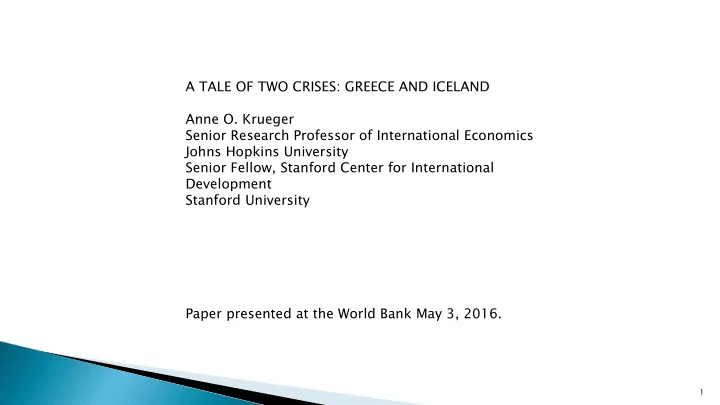

A TALE OF TWO CRISES: GREECE AND ICELAND Anne O. Krueger Senior Research Professor of International Economics Johns Hopkins University Senior Fellow, Stanford Center for International Development Stanford University Paper presented at the World Bank May 3, 2016. 1
2. Background 1. Greece’s boom was unsustainable and fiscal. Greece had joined the EU, and lower interest rates were a factor. Greece had micromanaged the economy in ways antithetical to growth. 2. Iceland’s boom was from an unsustainable credit boom. 3 large banks had borrowed abroad at high interest rates and collapsed. Iceland had a decade of sustainable growth before this. The problem was private debt, but banks could not just be left to fail. Iceland’s fiscal policy was sound and there was little public debt. Iceland’s economic regulation was business-friendly. Anne Krueger 2
1. Iceland’s came first in 2008 The crash was dramatic; stock market was down 80 percent and krone depreciated more than 70 percent. The 3 banks had to be dealt with. Iceland went to IMF and a program was in place by November 2008. Objectives were to stabilize the krone and the economy; fiscal deficit rose from plus ½% of GDP to deficit of 8.5 percent. Other program measures were to restore fiscal balance and balance of payments; capital controls were imposed as banks were sorted out. Anne Krueger 3
The program proceeded smoothly and growth resumed by late 2010. By 2015, real income was above 2008; capital controls are being removed gradually. 2. Greece increased deficit spending during the Great Recession but the crisis did not start until 2010 when a new government announced the fiscal hole was bigger than previously stated: Over 15% of GDP Greece could not use exchange rate flexibility or monetary policy Fiscal policy had to be tightened Greece’s economic policies involved many controls and distortions and were antithetical to growth. Anne Krueger 4
Debt was already high and Greece could not borrow. The troika complicated crisis management. Greeks resisted reforms in fiscal policy and in regulatory and other economic regulations. Implementation was a major issues. Targets were not met and Greece is still not back to precrisis level of income. Anne Krueger 5
Fiscal adjustment needed was smaller in Iceland but fiscal adjustment undertaken was as large. Iceland succeeded in keeping private bank liabilities from assumption by the public sector. Iceland’s implementation was very rapid. Iceland’s flexible exchange rate helped bring export growth soon. Anne Krueger 6
Widely accepted There had to be austerity. A floating exchange rate really helped. Restoration of growth is essential. There is need for speed in reforms. Debt sustainability must be assured. Delays are very costly. 7 Anne Krueger
Booms spurred by fiscal excesses and one by undue credit expansion have very similar consequences. Lack of fiscal space makes adjustment more painful. Putting banks at risk raises the costs of any crisis. Inflation may ease adjustment. The poor are disproportionately harmed by delay. Conclusion 8 Anne Krueger
9
10
11
12
13
14
Recommend
More recommend